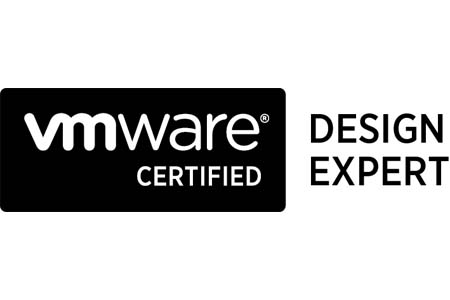 The VMware Certified Design Expert (VCDX) is the most elite certification that VMware offers. Those that earn it have proven they can operate at the highest levels of expertise, showing not only their advanced technical knowledge but also their ability to think on their feet, to identify and recognize customer requirements, and begin creating a conceptual design within minutes.
The VMware Certified Design Expert (VCDX) is the most elite certification that VMware offers. Those that earn it have proven they can operate at the highest levels of expertise, showing not only their advanced technical knowledge but also their ability to think on their feet, to identify and recognize customer requirements, and begin creating a conceptual design within minutes.
So it’s tough.
Earning this high level of certification requires a lot of preparation, practice, experience, knowledge, and aptitude. To help potential candidates, I asked for recommendations from those who have not only earned the VCDX already, but who also see candidates’ designs and defenses: our VCDX panelists. Straight from the mouths of the experts, here are some tips and suggestions to help you pass the VCDX design and defense:
Design for Reality
“Do not include unrealistic elements of designs (unlimited budgets, no constraints, etc.)”
– Agustin Malanco, VCDX 141
“Remember the purpose of your design is to deliver solutions to the business, super fancy technology options may be cool but completely irrelevant to the business and their requirements. Also, do not use constraints as a crutch, contemplate what could have been done if certain constraints were removed.”
– Matt Vandenbeld, VCDX 107
Cover all Elements
“Do not use ‘out of scope’ or ‘next phase’ as a crutch in the VCDX. While these do happen in the real world, there are specific areas in the VCDX that need to be covered in order to pass the defense. If you simply blow off Recoverability by saying you are doing it in the next phase without any details, there is no way for us to score for that. If your design is real and this actually happened, that is fine, but include how you would have done it. Otherwise you waste a lot of time in your defense.”
– Joe Silvagi, VCDX 175
Check your Assumptions
“Review your assumptions, if an assumption is wrong and can have a significant impact to the design outcome then it needs to be validated.”
– Mike Tellinghuisen, VCDX 111
Understand the Customer’s Needs
“Demonstrate that you have taken time to understand the customer’s needs and have taken care to map those needs into the design itself. It is one thing to provide lists of Requirements, Risks and Constraints. It is quite another to show how each one applies to the submitted design. Make sure each of these items is reflected in the design and it is clear how.”
– Doug Baer, VCDX 19
Probe Deeper into Requirements
“During your customer requirements gathering workshops, be sure to cover all five design qualities: Availability, Manageability, Recoverability, Performance and Security. Help the customer understand what they mean and work with them to identify their own requirements. Too often customer requirements are missed, and when questioned we regularly hear something similar to the following statement, ‘The customer didn’t have any Security requirements’. Ask yourself, did you ask the customer whether it’s OK if all users can to login to vCenter as an Administrator user? Or whether it’s OK for their ESXi Hosts to be on a publicly facing network? 99% of customers would not want either of these examples, which means that they actually do have some basic Security requirements. Make sure you ask the right questions. Without the right answers, it’s very difficult to create a successful design.”
– Simon Long, VCDX 105
“A good design starts with a detailed conceptual design, made up of the requirements, constraints and assumptions identified by the architect. If you start with a strong conceptual design then the logical and physical designs will also be strong. Requirements should be specific and the design should be able to verify it has met them through an operational verification plan. Requirements like “improved login times” or “fully secure” are vague and cannot be proven; how much do the login times need to be improved or what is the definition of fully secure and how will that be measured?”
– Travis Wood, VCDX 97
Know your Design’s Risks
“Risks to a design are just important as the requirements. Not only should you understand how a design will function to meet the requirements, you should understand ways it could potentially fail. Understanding the risks to the design and how they will impact your underlying requirements is key to passing the VCDX.” – Joe Silvagi, VCDX 175
Avoid Generic Templates and Default Settings
“If all of the requirements can be satisfied by simply installing software with its default settings, either the full scope is not understood, or the design work required for this solution is not substantial enough for the candidate to be evaluated adequately. Submitting generic or template material is a missed opportunity for a candidate to showcase his or her skills and credibility.”
– Doug Baer, VCDX 19
“Be careful using predefined templates for your design that are meant as tools in the field. Adherence to their form may not satisfy the objectives in the blueprint or the metrics used to qualify one’s knowledge of the objectives. Candidates may feel that an objective is met by mentioning the objective along with a setting or feature but not fully explaining how their design leveraged its use or a decision process was reached. These templates come off as too mechanical with no decisive information. Worse, strict adherence to templates may provide only a set of lists with no coherent flow of what the network topology will be, no discussion of specific use cases leveraging the intended design or an idea of any problem being solved since little to no “network discussion” is included. Remember, this vertical involves a network design! Panelists may be left with little to gauge whether the candidate understands the use of a service/feature/topology, etc. Let your thoughts flow into the written discussion in the design portion of the submission.”
– Paul A. Mancuso, VCDX 159
“Templates don’t help you stand out. If I see a design that’s completely fresh I read every word in detail to see what the architect’s justifications are. If you are going to use a template, customize the diagrams and the layout enough that it will demonstrate you put effort into the document.”
– Travis Wood, VCDX 97
Show Your Mastery
“You want a design that allows you to demonstrate your mastery of the skills across the rubrics. A design too simple may not have enough requirements, whilst a complex design may be too difficult to justify and rationalize in the limited time frame. If the design includes constraints that force you into making less optimal decisions then remove them from your submission and redesign that section. Conversely if the design was too simple that you couldn’t demonstrate mastery of security or recoverability, then add them for your submission and modify your design accordingly.”
– Travis Wood, VCDX 97
What else contributes to a good design and defense? Add your thoughts to the comments below.





